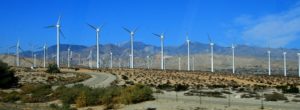
Wind power is designed to stop or at least slow down global warming. Now it becomes clear that wind turbines heat the earth, especially at night.
Whether humanity can effectively withstand the global warming caused by changes in the flower bed, nobody can say with absolute certainty. However, there is no shortage of efforts aimed at stopping, at least, the slowdown of climate change.
One of the key measures in this program of action is a change in the paradigm in energy development: the consistent abandonment of systems, which mainly include the burning of hydrocarbons, and the transition to systems that use alternative renewable energy sources – wind, sun, heat of the earth’s interior, sea waves, surf, etc. For example, wind farms are already making a significant contribution to energy conservation. And, it was thought, in the fight against global warming.
Wind parks as a factor in warming?
The big shock to the public was the report of a group of scientists that in the United States on a large area built up by wind turbines, the average daily temperature has increased by 33 degrees Faringate over the past 9 years. True, the authors of the study themselves urge not to dramatize the situation and not hurry with conclusions.
Liming Zhou, a professor at the University of New York State, explains: “This figure refers only to the region and the time period that was the subject of our study. And this circumstance should be taken into account, otherwise – there is a high risk of misinterpreting the results received. People can say: “So, it turns out that in 100 years the temperature will increase by almost 46 degrees? Wow! Even steeper than any global warming! ” Scientists like to avoid similar sensations.
But the very fact of the influence of large wind farms, like the Texas, on local climatic conditions is no longer in doubt. Professor Zhou says: “At first I saw several studies where calculations were made on models. It was evident from them that large wind farms could affect weather and climate. And it came to my mind that when it really is, it can be seen in the data coming from the meteorological satellites. ”
The scientist refers to satellites that record the temperature on the Earth’s surface, that is, the thermal radiation that our planet throws back into space. The analysis of these data showed that the territory densely built up by windmills really emit more heat per unit area than the area free from wind turbines. In addition, the difference is especially great at night.
The temperature of the ground and the air temperature are different things
According to Professor Zhou, the effect is explained by the fact that blades of wind turbines mix air layers near the earth’s surface. The mechanism here is as follows: after sunset, the soil cools faster from the atmosphere, so a layer of cold air forms on the very surface of the earth. Wind turbine turbines mix this cold layer with a slightly warmer layer placed so that the soil warms up as a result.
Why this effect, albeit in a weakened form, manifests itself in the afternoon, scientists can not yet explain. And its magnitude, that is, the level of temperature increase in the atmosphere, is not easy to assess, says Professor Zhou: “In our work we are talking about the temperature on the earth’s surface. This is not the same as the air temperature that appears, say, in weather data. The temperature on the surface of the soil undergoes more significant daily oscillations than the temperature of the air. So, in the indicators that are common to a wide audience, the effect of the warmth we have discovered will probably be less. ”
On a global scale, the effect is too small
In other words, more accurate – up to one hundredth of a degree! – the results of measurements should not be understood in such a way that the researchers thoroughly understood all the nuances of the impact of wind farms on the atmosphere. Rather the opposite. For example, David Kate, a professor at Harvard University, who is one of the first researchers to pay attention to the relationship between wind power plants and the atmosphere, does not attach much importance to the detected effect.
He believes that on a global scale, it is negligible, it could be neglected, even if all the energy needs of mankind were covered only at the expense of wind farms. However, the scientist admits that the effect has not yet been studied and that the global effects of wind turbines on local weather and the local microclimate are likely to be taken into account. Moreover, the number and size of wind farms around the world are growing rapidly. In particular, only in the United States – about 35 percent per year.
Picture Credit: cybergalactic
